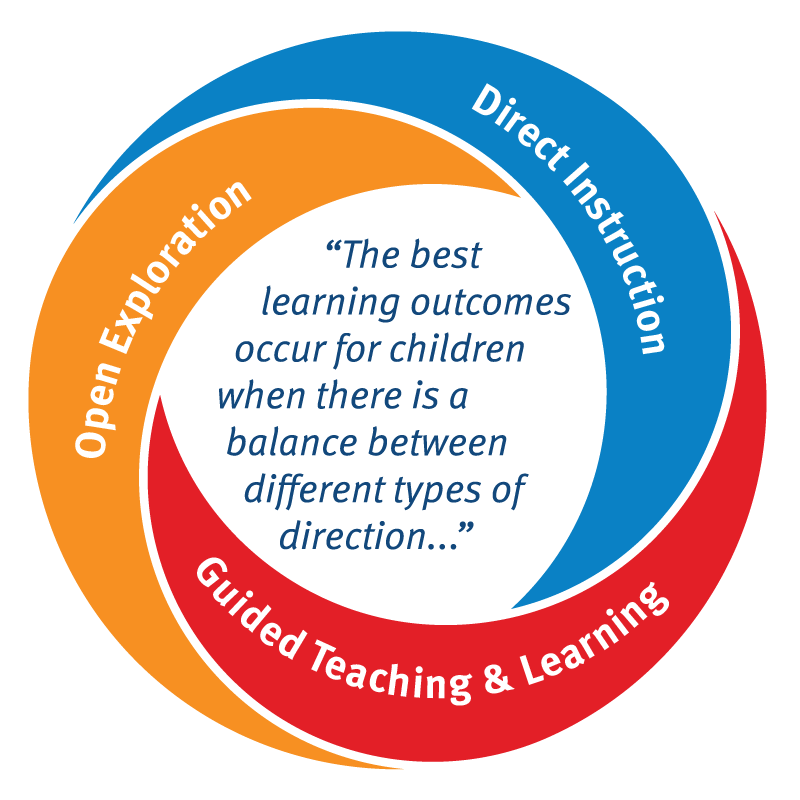The concept of “whole learner” is predicated on instructional approaches that effectively weave together direct instruction (in which adults provide initial framing and explicit instruction), guided teaching and learning (in which students have the opportunity to investigate, iterate, and learn through self-directed experiences within a framework constructed by educators, with grounding in specific pedagogy)⁵, and open exploration (in which learners are encouraged to make their own choices about the content and process of learning).⁶
“The best learning outcomes occur for children when there is a balance between different types of direction, and opportunities for all types are planned and provided for.”7 Integrated approaches—those that combine different levels of teacher and child-directedness—“can positively affect student learning across social, emotional, physical, creative, and cognitive domains, [and] these pedagogies can altogether create learning experiences for children that are meaningful, actively engaging, iterative, socially interactive, and joyful.”8
Across the continuum of learning, educators have a vital role to play in designing and scaffolding learning experiences that allow for the exploration and development of self-efficacy, while remaining grounded in concrete learning goals that support the development of a breadth of skills. Effective whole-learner approaches leverage guided instruction, modeling, practice, and a lot of feedback to ensure learners have all the resources, knowledge, and skills required to pursue more complex thinking and tasks over time. Addressing the multiple, interconnected components of development enables students to learn and internalize concepts more deeply. This is critical because, beyond the accumulation of specific knowledge, developing conceptual understanding allows children to more successfully connect concepts and skills, apply their knowledge to different situations, and spark new ideas.⁹
Similarly, just because an exclusive emphasis on academic achievement represents a barrier to the development and adoption of whole-learner approaches (which recognize development and learning outcomes as necessarily interconnected), it certainly doesn’t mean that academic outcomes are in any way deprioritized in whole-learner approaches. Effective whole-learner approaches embody the understanding that academic content and knowledge acquisition are strengthened and sustained when all of the skill domains—physical, social, cognitive, creative, and emotional—are addressed in a seamless and interwoven manner, and are taught in classrooms where students feel supported by trusting, positive relationships and a system of integrated supports.10

“Make 4”
Take, for example, the math problem “2+2.” When an educator calls on a particular child and asks for the answer to “2+2,” that child may well know the answer is 4. However, the experience of answering the question fails to create a connection to deeper learning and leaves out the other learners in the classroom. Imagine an educator asking all the students, “Show me how many ways you can make 4,” and inviting the students to work together using a diverse range of materials. Now, instead of focusing merely on recalling the correct answer, all of the children are meaningfully engaged in an experience that allows for differentiated learning. Children can gain a deeper understanding of the mathematical concepts—including addition and subtraction, and maybe even multiplication or division—at their own “just right” level. As important, they can also develop other skills in addition to mathematical ones: creativity, executive function, collaboration, communication, and many others. This principal holds true as learners get older and the subject matter becomes more complex. Approaches that engage learners and give them agency in demonstrating a chemical reaction, simulating an event from history, or finding multiple routes to solve advanced math problems help students develop a wider range of skills and lead to learning that is more motivating, resonant, and lasting.
Creating meaningful, engaging whole-learner experiences by prioritizing integrated pedagogies—combining direct instruction, guided teaching and learning, and open exploration opportunities—is key to providing learners a firm grasp of academic content, as well as developing the breadth of skills necessary for every young person to become a lifelong learner and an engaged, productive member of society.
5 Golinkoff, R.M., & Hirsh-Pasek, K. (2016). Becoming Brilliant: What Science Tells Us About Raising Successful Children. APA Press: Washington, D.C.
6 Marbina, L., Church, A., Tayler, C., & Centre for Post-Compulsory Education and Lifelong Learning (2011). Victorian Early Years Learning and Development Framework: Evidence paper: practice principle 6: Integrated teaching and learning approaches.
7 Marbina, L., Church, A., Tayler, C., & Centre for Post-Compulsory Education and Lifelong Learning (2011). Victorian Early Years Learning and Development Framework: Evidence paper: practice principle 6: Integrated teaching and learning approaches.
8 Parker, R., & Stjerne Thomsen, B. (March 2019). Learning through play at school. LEGO Foundation, DK.
9 Winthrop, R., & McGivney, E. (May 2016). Sills for a Changing World: Advancing Quality Learning for Vibrant Societies. Center for Universal Education at Brookings, U.S.
10 Darling-Hammond, L., Flook, L., Cook-Harvey, C., Barron, B., & Osher, D. (2020). Implications for educational practice of the science of learning and development, Applied Developmental Science, 24:2, 97-140, DOI: 10.1080/10888691.2018.1537791.


